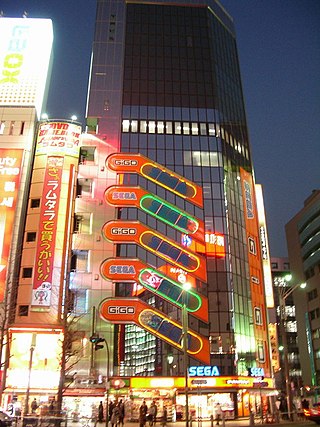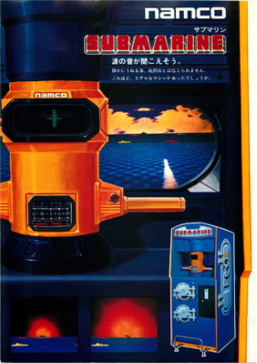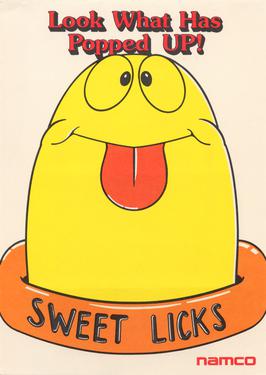
An amusement arcade, also known as a video arcade, amusements, arcade, or penny arcade, is a venue where people play arcade games, including arcade video games, pinball machines, electro-mechanical games, redemption games, merchandisers, or coin-operated billiards or air hockey tables. In some countries, some types of arcades are also legally permitted to provide gambling machines such as slot machines or pachinko machines. Games are usually housed in cabinets.

Pole Position is an arcade racing simulation video game released by Namco in 1982 and licensed to Atari, Inc. for US manufacture and distribution, running on the Namco Pole Position arcade system board. It is considered one of the most important titles from the golden age of arcade video games. Pole Position was an evolution of Namco's earlier arcade racing electro-mechanical games, notably F-1 (1976), whose designer Sho Osugi worked on the development of Pole Position.

Namco Limited was a Japanese multinational video game and entertainment company, headquartered in Ōta, Tokyo. It held several international branches, including Namco America in Santa Clara, California, Namco Europe in London, Namco Taiwan in Kaohsiung, and Shanghai Namco in mainland China.
David M. Rosen is an American businessman and the co-founder of the Japanese video game company Sega. He retired from the company as Chairman in 1996.
Centuri, formerly known as Allied Leisure, was an American arcade game manufacturer. They were based in Hialeah, Florida, and were one of the top six suppliers of coin-operated arcade video game machinery in the United States during the early 1980s. Centuri in its modern inception was formed when former Taito America president Ed Miller and his partner Bill Olliges took over Allied Leisure, Inc. They renamed it "Centuri" in 1980.

Starblade is a 1991 3D rail shooter arcade game developed and published by Namco. Controlling the starfighter FX-01 "GeoSword" from a first-person perspective, the player is tasked with eliminating the Unknown Intelligent Mechanized Species (UIMS) before they wipe out Earth. Gameplay involves controlling a crosshair with a flight yoke stick and destroying enemies and their projectiles before they inflict damage on the player.

SubRoc-3D is a first-person arcade shooter game released in 1982 by Sega. It is the first commercial video game in stereoscopic 3-D, using a periscope-shaped display with a different image for each eye. It was jointly developed by Sega and Matsushita Electric, who developed its active shutter 3D system. The game has stereo sound, and also changes the backdrop to reflect day, night, dawn, and dusk.

Super Monaco GP is a Formula One racing simulation video game released by Sega, originally as a Sega X Board arcade game in 1989, followed by ports for multiple video game consoles and home computers in the early 1990s. It is the sequel to the 1979 arcade game Monaco GP. The arcade game consists of one race, the Monaco Grand Prix, but later ports added more courses and game modes based on the 1989 Formula One World Championship.

Sea Wolf is an arcade video game designed by Dave Nutting and released by Midway in 1976. It is a video game update of an electro-mechanical Midway game, Sea Devil, itself based on Sega's 1966 electro-mechanical arcade submarine simulator Periscope. The game was released in Japan by Taito. In Sea Wolf, the player, piloting an unseen submarine, launches torpedoes vertically in an attempt to sink ships moving horizontally across the screen before time runs out. The screen is viewed through a faux periscope mounted on the cabinet.

F-1 is a 1976 electro-mechanical arcade racing game developed and published by Nakamura Manufacturing Company (Namco), and distributed in North America by Atari, Inc. The player uses a steering wheel to control a Formula One racer, which must avoid collision with other vehicles. The game uses a miniature diorama with small, plastic cars to represent the player's car and opponents on a physical, rotating track, while also featuring a projector system and lighting tricks to create the illusion of racing.

Monaco GP is an arcade racing game released by Sega in November 1979 in Japan, and January 1980 worldwide. An upgraded version, Pro Monaco GP, was released later in 1980. One of the last Sega games to use TTL chips instead of a microprocessor CPU, the game has players race against a clock and pass rival racers while attempting to earn points driving through five areas.

Masaya Nakamura was a Japanese businessman and the founder of Namco. He was the company's president up until 2002, where he took a ceremonial role in its management. Following the formation of Bandai Namco Holdings, Nakamura would retain an honorary position in the video game division, Bandai Namco Entertainment.
Light-gun shooter, also called light-gun game or simply gun game, is a shooter video game genre in which the primary design element is to simulate a shooting gallery by having the player aiming and discharging a gun-shaped controller at a screen. Light-gun shooters revolve around the protagonist shooting virtual targets, either antagonists or inanimate objects, and generally feature action or horror themes and some may employ a humorous, parodic treatment of these conventions. These games typically feature "on-rails" movement, which gives the player control only over aiming; the protagonist's other movements are determined by the game. Games featuring this device are sometimes termed "rail shooters", though this term is also applied to games of other genres in which "on-rails" movement is a feature. Some, particularly later, games give the player greater control over movement and in still others the protagonist does not move at all. On home computer conversions of light-gun shooters, mouse has been often an optional or non-optional replacement for a light gun.

Road Race is a 1976 car driving arcade racing video game developed and released by Sega in February 1976. Later the same year, Sega released two motorbike racing variants, Man T.T. and Moto-Cross, which were in turn re-branded as Fonz, in November 1976. The game was based on the character Fonzie from the 1970s TV show Happy Days, with the slogan being "TV's hottest name, Your hottest game". Sega licensed Fonz because at the time it was owned by Charles Bluhdorn's Gulf+Western Company and it was a Paramount Television intellectual property.
Electro-mechanical games are types of arcade games that operate on a combination of some electronic circuitry and mechanical actions from the player to move items contained within the game's cabinet. Some of these were early light gun games using light-sensitive sensors on targets to register hits, while others were simulation games such as driving games, combat flight simulators and sports games. EM games were popular in amusement arcades from the late 1940s up until the 1970s, serving as alternatives to pinball machines, which had been stigmatized as games of chance during that period. EM games lost popularity in the 1970s, as arcade video games had emerged to replace them in addition to newer pinball machines designed as games of skill.

Submarine is an electro-mechanical arcade game that was released by Namco in 1978, and was licensed to Midway for US manufacturing and distribution in September 1979.

Sweet Licks, known as Okashi Daisakusen in Japan and Choco-Kid in Europe, is a 1981 coin-operated redemption mole-buster arcade game developed and published by Namco. Players use a foam-covered mallet to whack the eight "Pyokotan" cake monsters that emerge from the colored holes placed on the machine. Points are awarded for hitting them, and the speed of the game increases until the time limit runs out. Hitting 40 Pyokotan will increase the timer by 15 seconds.

An arcade video game is an arcade game where the player's inputs from the game's controllers are processed through electronic or computerized components and displayed to a video device, typically a monitor, all contained within an enclosed arcade cabinet. Arcade video games are often installed alongside other arcade games such as pinball and redemption games at amusement arcades. Up until the late 1990s, arcade video games were the largest and most technologically advanced sector of the video game industry.

An arcade game or coin-op game is a coin-operated entertainment machine typically installed in public businesses such as restaurants, bars and amusement arcades. Most arcade games are presented as primarily games of skill and include arcade video games, pinball machines, electro-mechanical games, redemption games or merchandisers.
















